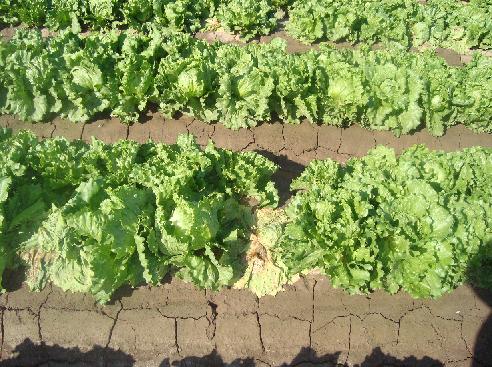 |
|
|
|

|
|||
| |
|||
Successful management of any plant disease is achieved by focusing control efforts on one or more vulnerable stages in the disease cycle of the pathogen. For lettuce drop caused by the fungi Sclerotinia minor and S. sclerotiorum, this point of attack is the sclerotial stage of each pathogen. At crop maturity, sclerotia produced on infected plants will be incorporated into the soil along with crop debris when the land is prepared for planting of the next crop. For Sclerotinia, sclerotia serve the same purpose that seeds do for plants; that is, to allow the organism to carry over in soil in a dormant state until conditions become favorable for germination and growth. Sclerotia are the target for control of lettuce drop. Over the past 10 years of research trials, the traditional application of fungicides to the lettuce bed surface after thinning has provided at best about a 50 to 60% reduction in dead plants, compared to plots not receiving a fungicide treatment. Application of fungicides to the bed surface prevents germination of sclerotia at or near the soil surface, but has little effect on sclerotia deeper in the soil profile. Experiments conducted for the past three years demonstrated that physically incorporating a fungicide (Endura) into the bed to a depth of 2 inches increased the level of disease control over that observed in plots where the same fungicide was applied to the bed surface. Over the three separate field trials, the average level of disease control achieved through soil incorporation compared to soil surface application of Endura was 68% compared to 59% in the presence of S. minor and 62% compared to 53% in the presence of S. sclerotiorum. Similar results were obtained for Rovral in plots containing S. sclerotiorum; however, in two of three trials, incorporation of Rovral into the soil resulted in less disease control compared to soil surface application in plots containing S. minor. Soil incorporation consistently improved the efficacy of Endura; however, since each fungicide has unique chemical properties that affect movement and behavior in soil, the usefulness of this application technique for other fungicides will need to be evaluated in the future. Lettuce Drop Symptoms To contact Mike Matheron go to: matheron@ag.arizona.edu.
|
|||
| Back | |||
For questions or comments on any of the topics please contact Marco Pena at the Yuma Agricultural Center. |
|||
| Home | Cotton
| Veggies | Forages
| Grains | Citrus
| Crop x Crop Insects | Diseases| Weeds | Pesticides | Economics | News | Weather | Research | Photos | Contacts | General Info. Copyright © 2001 University of Arizona, College of Agriculture and Life Sciences Webmaster: Al Fournier (acis@ag.arizona.edu) |
|||
